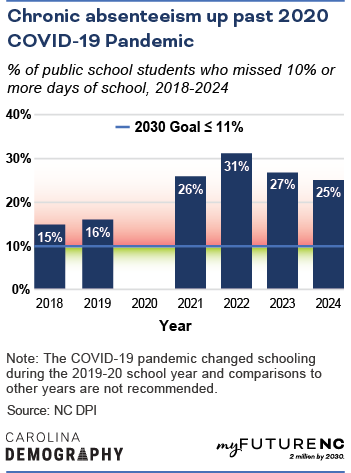Percentage of North Carolina K-12 students who missed 10 percent or more of school days (indicator shown as distance from 100%)
Data year: 2024
= Top southern state :
only available for totals, not available for all indicators
What does Chronic Absenteeism mean?
What does this data show?
North Carolina’s chronic absenteeism rate is 25%, meaning 25% of K-12 students in North Carolina missed 10 percent or more of school days during the 2023-24 school year.
By 2030, the goal is to reduce the statewide chronic absenteeism rate to 11%. This goal was set by the myFutureNC Commission.
Why does Chronic Absenteeism matter?
Being physically present in school is a necessary precursor to learning. Chronic absenteeism in early grades may prevent children from developing the skills they need to succeed in later grades. High rates of chronic absenteeism do not only affect the students who are absent but also their classmates. Research has repeatedly found a “clear and consistent relationship between early attendance and later achievement,” including:
- Lower academic performance in 1st and 5th grades
- Persistently lower academic scores in grades 3-5
- An increased likelihood of reading below grade level
- An increased likelihood of needing reading intervention
In middle grades, chronically absent students are less likely to be on-track to graduate from high school on time. In fact, improving attendance is a better predictor of high school outcomes than test score improvement.
Once in high school, chronically absent students are less likely to graduate and less likely to attend college. Moreover, the risks and effects of chronic absenteeism are not equally distributed. The national organization, Attendance Works, notes that chronic absenteeism disproportionately affects economically-disadvantaged students:
“Children living in poverty are two to three times more likely to be chronically absent—and face the most harm because their community lacks the resources to make up for the lost learning in school. Students from communities of color as well as those with disabilities are disproportionately affected.
This isn’t simply a matter of truancy or skipping school. In fact, many of these absences, especially among our youngest students, are excused. Often absences are tied to health problems, such as asthma, diabetes, and oral and mental health issues. Other barriers including lack of a nearby school bus, a safe route to school or food insecurity make it difficult to go to school every day. In many cases, chronic absence goes unnoticed because schools are counting how many students show up every day rather than examining how many and which students miss so much school that they are falling behind.”
The Enduring Effect of the Pandemic
The COVID-19 global pandemic worsened chronic absenteeism in North Carolina and the entire U.S., resulting in a national chronic absenteeism rate of 31% during the 2021-22 school year. The pandemic affected the chronic absenteeism rates of all racial/ethnic groups and affected school districts similarly, regardless of their pre-2020 chronic absenteeism rates. The reasons for the increases in chronic absenteeism are still unclear, but the negative effects on student outcomes are substantial. Research from the Education Policy Institute at Carolina shows that following the pandemic, the number of students who experienced chronic absenteeism in the last three years has more than doubled compared to pre-pandemic, chronic absenteeism has become more prevalent (1 in 13 students experience chronic absenteeism in each of the three years following the pandemic), and that Black and Hispanic students, as well as students in high-poverty schools, were more likely to experience both chronic absenteeism and persistent chronic absenteeism following the COVID-19 pandemic.
How is North Carolina performing?
Meeting the 2030 Goal
North Carolina needs 218,720 more students to attend school more regularly to meet the statewide goal of less than 11% of students who are chronically absent.

In 2024, North Carolina’s chronic absenteeism rate was 25%, up from 15% in 2018.
Trends
Prior to the 2020 school year, chronic absenteeism rates in North Carolina were above the state goal of 11%, but considerably lower than they have been in the years following the pandemic. In 2022 the rate hit a high of 31%.
Between 2023 and 2024, the chronic absenteeism rate decreased by two percentage points from 27% to 25%, the lowest percentage since before the pandemic. 2020 data is excluded due to inconsistent reporting because schools were not required to report attendance from March 30th to May 15th of 2020.
By geography
 Students from rural counties had the highest chronic absenteeism rates in 2024 with rural-non-metro at 29% and rural-metro at 28%. Students from suburban areas had the lowest chronic absenteeism rates (25%), and students from urban areas had the second lowest (27%).
Students from rural counties had the highest chronic absenteeism rates in 2024 with rural-non-metro at 29% and rural-metro at 28%. Students from suburban areas had the lowest chronic absenteeism rates (25%), and students from urban areas had the second lowest (27%).
By sex
Chronic absenteeism rates for both male students and female students were 25% in 2024.
By race/ethnicity
Asian students (11%) were the only racial or ethnic group in 2024 that met the state goal of 11%. White students had the next lowest rates (20%) followed by Hispanic students (28%) and Multiracial students (29%). Black students had the second highest rates of chronic absenteeism (32%), and American Indian students had the highest rates of chronic absenteeism among all racial and ethnic groups at 41%.
Methodology
Where does the data for Chronic Absenteeism come from?
The detailed North Carolina data on chronic absenteeism for 2023-2024 was received by special request from the North Carolina Department of Public Instruction and are part of the North Carolina Student Report Cards, which can be viewed online. North Carolina trend data are also from the North Carolina Report Cards.
How was the data calculated?
The rate of chronic absenteeism is calculated by dividing the number of students reported as chronically absent by the total number of students enrolled for at least 10 days in a school year. The North Carolina Department of Public Instruction defines enrollment as “a count of students who have simply enrolled in and started attending a particular school.” It is possible for a student to be counted as chronically absent at more than one school throughout the school year.

Chronic Absenteeism Rate = (Number of students absent for 10% or more of days enrolled) / (Total number of students enrolled at least 10 days)
Who is included?
All North Carolina public school students (traditional public schools, charter schools, and alternative schools).
Who isn’t included?
Students in federal schools, state-operated schools, other special schools, private schools, and home schools.
Learn more
Who is working on this in NC?
Help improve this section
If you know of an organization that is working on this topic in NC, please let us know on the feedback form.
Name: Attendance Works
Scope: National
Website: https://attendanceworks.org
About: Attendance Works is a national initiative that pushes for better policy and practice to improve school attendance.
Name: NC Early Childhood Foundation
Scope: Statewide
Website: https://buildthefoundation.org/
About: The mission of the NC Early Childhood Foundation (NCECF) is to “marshal North Carolina’s great people, ideas and achievements to build a foundation of opportunity and success for every child by the end of third grade.” NCECF engages business, faith, law enforcement, and community leaders as early childhood champions to effectively communicate the broad societal impact of policies that affect early development and learning. NCECF leads and supports state and local collaborations – bringing together birth-through-eight health, family support, and education leaders across government, policy, private, nonprofit, philanthropic and research sectors – to advance a shared vision and course of action for maximum impact for children and families. NCECF also provides policymakers, advocates, business leaders and the public with research and analysis about the impact of federal and state birth-to-eight policy and innovations proven to achieve results for young children.
NC-focused, state-level dashboard
Name: NC School Report Cards
Website: https://www.dpi.nc.gov/data-reports/school-report-cards
About: North Carolina’s school report cards are an important resource for parents, educators, state leaders, researchers, and others, providing information about school- and district-level data in a number of areas. These include student performance and academic growth, school and student characteristics, and many other details.
Further research and literature
Attendance Works. (2016). Key Research: Why Attendance Matters for Achievement and How Interventions Can Help. Retrieved December 16, 2019, from https://awareness.attendanceworks.org/wp-content/uploads/Research2016.pdf
Balfanz, R., Herzog, L., & Mac Iver, D. J. (2007). Preventing Student Disengagement and Keeping Students on the Graduation Path in Urban Middle-Grades Schools: Early Identification and Effective Interventions. Educational psychologist, 42(4), 223–235.
Balfanz, R. (2024, May 14). Meeting the Chronic Absenteeism Challenge: What Do We Know?. Baltimore, MD: Everyone Graduates Center, School of Education, Johns Hopkins University. https://www.gradpartnership.org/wp-content/uploads/2024/05/EGC-GP-NPSS-May-2024-Brief.pdf
Bauer, L., Liu, P., Schanzenbach, D. W., & Shambaugh, J. (2018). Reducing Chronic Absenteeism under the Every Student Succeeds Act. Washington, DC: The Hamilton Project.
Buehler, M. H., Tapogna, J., & Chang, H. N. (2012). Why Being in School Matters: Chronic Absenteeism in Oregon Public Schools. Attendance Works.
Chang, H. N., Bauer, L., & Byrnes, V. (2018). Data Matters: Using Chronic Absence to Accelerate Action for Student Success – Attendance Works. Attendance Works and Everyone Graduates Center.
Chang, H. N., & Romero, M. (2008). Present, Engaged, and Accounted For: The Critical Importance of Addressing Chronic Absence in the Early Grades. New York: National Center for Children in Poverty.
Dee, T. S. (2024). Higher chronic absenteeism threatens academic recovery from the COVID-19 pandemic. Proceedings of the National Academy of Sciences, 121(3), e2312249121. https://doi.org/10.1073/pnas.2312249121
Ehrlich, S. B., Gwynne, J. A., Pareja, A. S., Allensworth, E. M., Moore, P., Jagesic, S., & Sorice, E. (2014). Preschool Attendance in Chicago Public Schools: Relationships with Learning Outcomes and Reasons for Absences. Chicago, IL: University of Chicago Consortium on Chicago School Research.
Jacobs, B. A., & Lovett, K. (2017, July 27). Chronic absenteeism: An old problem in search of new answers. Retrieved December 17, 2019, from https://www.brookings.edu/research/chronic-absenteeism-an-old-problem-in-search-of-new-answers/
North Carolina Early Childhood Foundation. (2018, February 21). NC State Board of Education Establishes Definition of Chronic Absenteeism. Retrieved December 8, 2019, from https://buildthefoundation.org/2018/02/nc-state-board-of-education-establishes-definition-of-chronic-absenteeism/
Swiderski, T., Fuller, S. C., & Bastian, K. C. (2025). Student-Level Attendance Patterns Across Three Post-Pandemic Years. Educational Evaluation and Policy Analysis, 0(0). https://doi.org/10.3102/01623737251315715
U.S. Department of Education. (n.d.). Chronic Absenteeism. https://www.ed.gov/teaching-and-administration/supporting-students/chronic-absenteeism
FAQ
Which absences from school contribute to a student being chronically absent?
According to NC DPI: “Student chronic absence refers to missing so much school, for any type of absence—excused, unexcused, disciplinary—that a student is at risk of falling behind.”
Where can I learn more about the Civil Rights Data Collection?
The U.S. Department of Education maintains a FAQ on Civil Rights Data Collection.
Where can I learn more about chronic absenteeism post-pandemic?
Carolina Demography published a piece in March 2023 looking at data from the pandemic and how it may differ from previous or future years.



